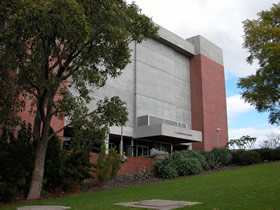
 Exterior of the Robertson Library, 2007.
Exterior of the Robertson Library, 2007.
 |
||||||||||||||||||||||||||||||||||||||||||||||||||||
| Endnotes | ||||||||||||||||||||||||||||||||||||||||||||||||||||
| 1. Garner, Imogen, 2012, 'The Library: a sense of place and a place in space' [personal communication] | Back |
|
||||||||||||||||||||||||||||||||||||||||||||||||||
| 2. Curtin University Library, 'Robertson Library vision and action plan', 2012 | Back | |||||||||||||||||||||||||||||||||||||||||||||||||||
| 3. Curtin University Library, 'Robertson Library vision and action plan', 2012 | Back | |||||||||||||||||||||||||||||||||||||||||||||||||||
| 4. The remaining specialised binding work (including binding of Curtin students’ theses) was outsourced. | Back | |||||||||||||||||||||||||||||||||||||||||||||||||||
| 5. The Lounge was officially opened in June by the Vice-Chancellor and Pro Vice-Chancellor (Academic Services). | Back | |||||||||||||||||||||||||||||||||||||||||||||||||||
| 6. These small rooms had been under utilised by postgraduate students for some years. | Back | |||||||||||||||||||||||||||||||||||||||||||||||||||
| 7. Smart Boards are interactive whiteboards produced by the company Smart Technologies. A projector is used to display a computer's video output on the interactive whiteboard, which then acts as a large touch screen. | Back | |||||||||||||||||||||||||||||||||||||||||||||||||||
| 8. In the 2009 Western Australian Architecture Awards, Taylor Robinson Architects won the Interior Architecture Award for the planning and fit-out of the iZone and the Mondoluce Lighting Award for the use of artificial lighting to provide variety in light source and effect, concealment and exposure. | Back | |||||||||||||||||||||||||||||||||||||||||||||||||||
| 9. Curtin University Library, 'Robertson Library vision and action plan', 2012 | Back | |||||||||||||||||||||||||||||||||||||||||||||||||||
| 10. ‘Electronic preference expands library collections’, Curtin University Library newsletter, Winter 2012 | Back | |||||||||||||||||||||||||||||||||||||||||||||||||||
| 11. Hart, Sue, 2012, chapter on the University Library in an unpublished draft of the history of Curtin University of Technology. | Back | |||||||||||||||||||||||||||||||||||||||||||||||||||
| 12. In 2004 the Australian dollar was worth US$0.67 and in 2012 it reached parity with the US dollar. | Back | |||||||||||||||||||||||||||||||||||||||||||||||||||
| 13. In late 2006, the Library worked with the University’s Financial Services area to invest around 60% of the acquisitions expenditure in foreign currency, particularly US dollars. | Back | |||||||||||||||||||||||||||||||||||||||||||||||||||
| 14. Garner, Imogen, 2005, 'Library support for research in a university context', Embedding libraries in learning and research, 27th IATUL Conference, 22-25 May 2006, Faculdade de Engenharia, Universidade do Porto, Portugal. | Back | |||||||||||||||||||||||||||||||||||||||||||||||||||
| 15. For example, in 2006, the subscription to 6 000 monographs in the database IEEE (Institute of Electrical and Electronics Engineers) Xplore brought the total the number of e-books in the collection to over 11 500. | Back | |||||||||||||||||||||||||||||||||||||||||||||||||||
| 16. Prior to this, the Teaching Resources Library in the education building was relocated within the building to be part of a learning precinct which also housed a new 100 seat computer (Abacus) laboratory. | Back | |||||||||||||||||||||||||||||||||||||||||||||||||||
| 17. One outcome of the improved control of records was that in October 2005, the Library was able to make a significant contribution to the National Bibliographic Database when some 80 000 of its records and holdings information were uploaded to the national system. | Back | |||||||||||||||||||||||||||||||||||||||||||||||||||
| 18. Curtin University Library newsletter, Summer 2010 | Back | |||||||||||||||||||||||||||||||||||||||||||||||||||
| 19. InfoTrekk was developed by Library staff and provided a generic information literacy program of ten short, user friendly ‘treks’ that covered topics such as ‘Understanding your reading list’, ‘Finding journal articles’, and ‘Evaluating resources. | Back | |||||||||||||||||||||||||||||||||||||||||||||||||||
| 20. Endnote is a software program for publishing and managing bibliographies and references. | Back | |||||||||||||||||||||||||||||||||||||||||||||||||||
| 21. Some of the topics covered by the podcasts included subject specific resources, 'Keeping up to date', and 'Library etiquette'. The podcast on etiquette was suggested by a student who entered a competition the Library ran to elicit feedback on the online resources. | Back | |||||||||||||||||||||||||||||||||||||||||||||||||||
| 22. In 2006, a number of the Library’s innovative web resources including selected View-it tutorials, podcasts, InfoTrekk and InfoTrekk Plus were added to UNESCO’s International information literacy resources directory. | Back | |||||||||||||||||||||||||||||||||||||||||||||||||||
| 23. The education category of the Australian Web Awards was specifically for educational institutions and nominees needed to show how they supported the ongoing business of education and their major client groups. The two main criteria were the user experience and the fitness for purpose of the website. A mix of Australian and international web industry judges selected finalists from nearly 300 entries. | Back | |||||||||||||||||||||||||||||||||||||||||||||||||||
| 24. The Library implemented the HP Service Desk system, which was used University-wide to manage clients’ information technology and other queries, in 2007. | Back | |||||||||||||||||||||||||||||||||||||||||||||||||||
| 25. QR codes are two-dimensional codes which can store much more information than standard linear barcodes. They consist of square dots arranged in a square pattern on a white background. | Back | |||||||||||||||||||||||||||||||||||||||||||||||||||